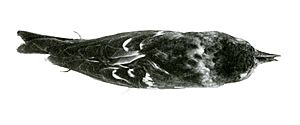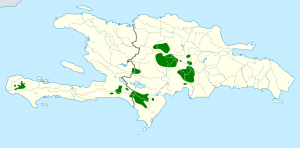Hispaniolan crossbill facts for kids
Quick facts for kids Hispaniolan crossbill |
|
|---|---|
 |
|
| Conservation status | |
| Scientific classification | |
| Genus: |
Loxia
|
| Species: |
megaplaga
|
 |
|
The Hispaniolan crossbill (Loxia megaplaga) is a special type of crossbill bird. It lives only on the island of Hispaniola, which is shared by Haiti and the Dominican Republic. This makes it an "endemic" species, meaning it's found nowhere else in the world! It's also the only crossbill bird found in the entire Caribbean region.
Contents
About the Hispaniolan Crossbill
Long ago, scientists thought the Hispaniolan crossbill was the same species as the two-barred crossbill. That bird lives far away in northern places. But now, experts believe the Hispaniolan crossbill actually evolved from the two-barred crossbill. It's a unique story of how a species can become isolated.
How This Bird Became Unique
Scientists think the Hispaniolan crossbill's ancestors came from southern groups of the two-barred crossbill. About 10,000 years ago, at the end of the last glacial period (the last Ice Age), the huge glaciers and big temperate coniferous forests started to melt and move north.
Some of these birds were left behind on the highest pine-covered mountains in Hispaniola. These mountains are the tallest in the Caribbean. This created a huge distance between the two groups of birds. Now, thousands of kilometers separate them! This amazing isolation makes the Hispaniolan crossbill's story very interesting for scientists who study nature.
A similar story happened with the rufous-collared sparrow. This bird lives from southern Mexico all the way down to Cape Horn. But it is also missing from all Caribbean islands except Hispaniola.
What the Hispaniolan Crossbill Eats
This bird has a very specific diet. It eats almost only the seeds from the cones of the Hispaniolan pine tree (Pinus occidentalis). This strong link to one type of tree makes it very special.
Protecting This Bird
The Hispaniolan crossbill is in trouble. Because it lives in a small area and has a small population, it is listed as "Endangered" by the IUCN. The IUCN is a group that helps protect nature. This means the bird is at high risk of disappearing forever.
Its population is split into small groups. Scientists believe its numbers are going down. This is mainly because people are clearing forests for farming. This causes the bird to lose its home.
The adult population is thought to be between 400 and 2,300 birds. Most of them live in the Sierra de Baoruco National Park. Sadly, this park does not have strong protection right now.
See also
 In Spanish: Piquituerto de La Española para niños
In Spanish: Piquituerto de La Española para niños


